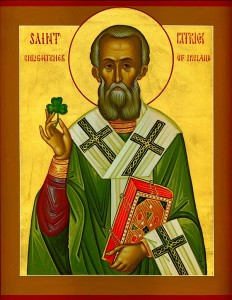Written by Erin Lawinger. Media by Emily Martiens.[divide]
Every year on March 17 communities celebrate St. Patrick’s Day. There are many traditions held for the holiday, but why is St. Patrick celebrated in the first place? Parades, religious services, dying water or beer green, pea planting, and of course, wearing the color green are holiday traditions, but what is the history behind this holiday?
Saint Patrick’s Story

St. Patrick’s story begins in Wales, Scotland when he was captured by pirates and taken to Ireland to be sold as a slave. For the next six years, he worked as a herdsmen tending to sheep and pigs. It was during this time that he became increasingly religious. He eventually escaped and was reunited with his family who were Romans living in Britain. There he had a vision that the Irish were calling him back to Ireland to teach them about God, however, he did not feel adequately prepared for life as a missionary despite being inspired. He then spent the next twelve years in France where he was trained in a monastery before returning to Ireland. His mission work is where the clover appeared, for it was a symbol he used to represent the Holy Trinity. This is also where the holiday’s green theme derived from. The date comes from St. Patrick’s death in 461 on March 17.
The History of Saint Patrick’s Day
St. Patrick’s Day was first celebrated in America in 1737 hosted by the Charitable Irish Society of Boston. The original celebration consisted of a feast and religious service to honor and celebrate the Irish culture that so many colonists had been separated from. In New York, the first celebration took place as a small gathering in the home of an Irish protestant. By 1762, St. Patrick Day parades were organized by Irish soldiers in the British military who marched down Broadway.
These traditions eventually evolved into the boisterous holiday that is celebrated today. Whether St. Patrick’s Day is celebrated in Boston, which brings over 600,000 visitors to the city, or Chicago, where they dye the Chicago River green, it is certainly one to be celebrated.




























